|
The history of the wolves' lineage can be traced back to an ancient species called creodonts. These creodonts branched off
to form the predecessors to the cat family and the predecessors to the dog family. These creatures are the ancestors of the
family Canidae. In this family is the genus Canis. Included in the Canis genus are the Canis familiaris, otherwise known as
the domestic dog; the coyote, Canis latrans; and the Gray (Canis lupus) and Red (Canis rufus) wolves.
The history of
the evolution of the wolf has been reconstructed through a combination of the fossil record and the analysis of genetic material.
Ron Nowak, a prominent wolf taxonomist, has proposed the following as a hypothesis as to how the wolves evolved:
Coyotes evolved from foxes four to five million years ago.
The coyotes split into two groups one to two million
years ago: the ancestor to today's coyote and a species that closely ressembles the Red wolf of today.
During the turbulent
climactic and topographical changes of the Pleistocene era, the original wolves crossed the Bering land bridge into Asia and
Europe.
In Eurasia, the colder climate called for a larger, stronger wolf.
In the Americas, a super large wolf,
called the "Dire" wolf, evolved mainly in South America.
These various species coexisted in North America for
years, before the "Dire" wolf died out.
The last major evolutionary changes to the wolf took place in Alaska,
where the Gray wolf was best suited. These wolves settled in Canada, the Western United States, and Siberia.
The more
primitive Red wolf settled into the southeastern United States.

There are two species of wolf in North America: the gray wolf and the red wolf. This site focuses primarily on the gray wolf;
however, the red wolf deserves mention as well.
Gray Wolf:
The gray wolf is the wolf that is generally envisioned
when one thinks of wolves. There are several subspecies of the gray wolf, including the timber wolf, the Rocky Mountain wolf,
the Arctic wolf, and the Mexican wolf. The gray wolf is primarily gray, but can range in color from white to black, with many
shades in between, including rust and cream. The male gray wolf is on average 5 to 6 1/2 feet long and weigh between 70 and
120 pounds. The female is generally about 20% smaller.
Red Wolf:
The red wolf is considerably
smaller than the gray wolf, with an average length around 4 feet. The wolf generally weighs between 50 and 70 pounds. The
red wolf resembles a coyote-wolf hybrid, and it is often debated whether the red wolf is truly a wolf. The red wolf has short
fur, compared to the gray wolf's long fur. Additionally, the red wolf has flecks of red in its fur, thus giving it its name.
Other differences from the gray wolf include larger ears and a narrower snout. The red wolf is being saved from extinction
through reintroduction programs in Tennessee and North Carolina.
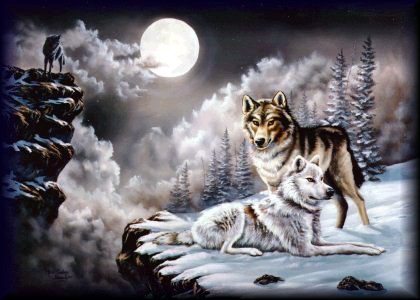
Wolves are very social animals, and live in a family type unit called a pack. Packs can range anywhere from two wolves to
over twenty wolves. Most packs in the continental United States have six to eight wolves, while packs in Alaska and Canada
have between ten and twenty wolves.
The pack is generally made up of an adult male and female who have mated and
produced offspring. Generally the pack is made up entirely from wolves who are related to each other, although a non-related
wolf may become a member of a pack.
The pack follows a strict hierarchy to help maintain order within the pack.
The main rankings in the hierarchy are alpha wolf, beta wolf, and omega wolf. The alpha wolf is the lead wolf and is the dominate
wolf of the pack. The next in line is the beta wolf. The beta wolf often acts the caretaker of the pups, as well as the discipliner
to reinforce the alpha's decisions. The omega wolf is the lowest ranking member of the pack. The omega wolf is subordinate
to all other wolves in the pack and must often feed on prey when the rest of the pack is done. The rankings often go in pairs,
so that there is a male and female of each rank, but this not always the case. Most often there is an alpha male and alpha
female, but there may not be pairings for the rest of the rankings. The other wolves fall between the beta wolf and the omega
wolf.
The alpha wolf often displays very confident characteristics. The alpha wolf has a very confident stride, generally
has the tail raised, and ears forward. The video shows the alpha male of the Sawtooth Pack displaying some of these characteristics.
Often even a look or glare from the alpha wolf is enough to cause another wolf in the pack to display subordinate behavior,
such as tucking the tail or lower the body and crawl to the alpha wolf.
The pack is a very tightly knit, highly
organized group. For survival a pack will travel, hunt, protect territory and raise pups together. Many believe that the pack
is one of the tightest social organizations known to man.
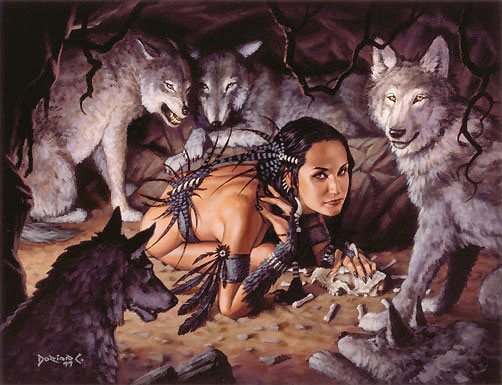
Wolf pups are born after a gestation period of 9 weeks. They are born in litters of between 2 and 10 pups. When first born,
wolf pups can't see or hear, and they need to stay close to their mother for warmth. They only weigh about one pound. They
stay in the den for the first few weeks of their lives, spending most of their time eating and sleeping.
After the
first two weeks, their eyes open. After three weeks, they can hear and walk, and they start eating solid food. When the wolf
pups are about a month old, they finally get to meet the rest of the pack.
Once the pups leave the den, they
are looked after by the entire pack. The pups bond with the other wolves in the pack. (If a wolf is raised by people instead
of wolves, it will bond to people at this point.) The older pack members help by bringing food back for the young pups and
watching for preadors like eagles and hawks who might try to take the pups. After the wolf pups are nine weeks old, the pack
moves from the den area to a site where the pups can safely play while the rest of the pack hunts.
Through playing,
the pups practice skills that will be important later in their lives, like pouncing, fighting and chasing. They even attack
the older wolves, who put up with all their energy pretty well. Playing helps the pups establish a social order among themselves.
Wolf pups do not begin to hunt until they are at least a year old. Wolves mate at the end of winter, generally between
January and April, so that the wolf pups are developed enough by the arrival of the next winter to grow strong and perhaps
even help with hunting. Wolves do not usually become sexually mature enough to mate until they are at least three years old.
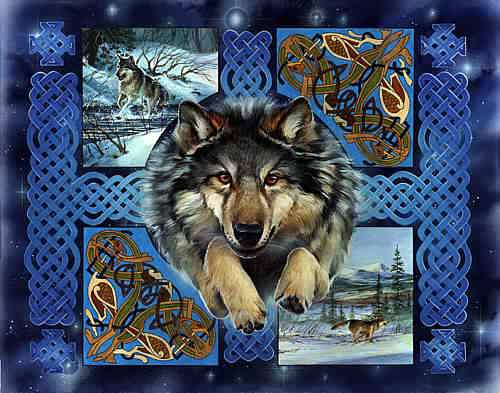
Wolves are social animals, and most wolves live in packs, although there are some lone wolves, too. Each wolf has an individual
personality, just like people do. As they grow and mature, their personalities change, often because of the place each wolf
holds within the pack. Additionally, the interactions between the wolves contributes to the development of the wolves and
the pack. The hierarchy of the pack helps maintain order, discipline and unity.
One important aspect of wolf development
is play. Wolves enjoy playful exchanges with each other. This video clip depicts two wolves from the same pack playing with
each other. This playfulness starts early as pups and continues throughout the wolves' lives. This play helps wolves develop
skills for hunting, defending and maintaining pack unity.
The pack is kept together by strong bonds of affection.
Conflict within the pack is unusual and a cause for great distress among the other wolves in the pack. However, wolves are
usually hostile towards wolves that do not belong to their own pack, since they are seen as a threat to the pack's unity and
survival.
Sometimes, wolves seem to treat people as if they were other wolves and act submissive in the face of
a person's self-confidence. Other times, they are shy and afraid of humans, since humans have caused wolves so much harm over
the years. Most humans are not observant enough to keep within a wolf's social code; for this reason and more, wolves are
not appropriate to keep as pets.
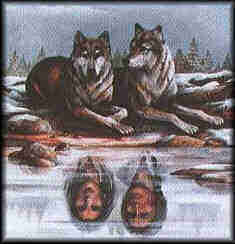
Wolves are carnivores, or meat eaters. They are also hunters, and eat their own kill. Their main prey are the large hooved
mammals of North America. These are moose, deer, caribou, elk and sheep. In order for the wolf to catch and kill these prey,
which are sometimes as much as ten times larger than it, hunting is a collaborative effort. The wolves hunt in groups, thereby
increasing their strength and their ability to catch their prey. If the wolf hunted alone, it would have to depend on prey
its size or smaller, which would not provide sustenance.
The Hunt
The identifying, pursuing, and capture
of the prey is a multi step process. It is also a process which can have several different outcomes.
The first scenario
is the successful hunt. A wolf pack will pick up the scent of the prey. This is done either by following tracks on the ground,
or by picking up the airborne scent. After picking up the scent, the wolves move as a unit towards their quarry. This must
be done quietly, so as not to alert their prey. Once the quarry is found, the wolves will surround the animal, biting it around
the backside, sides, neck and head. Once the wolves have successfully attacked, death comes very quickly.
However,
in most cases, the hunt is not successful. Either the intended prey will pick up the scent of the wolves and run, or in the
case of the much larger prey such as the moose, the prey will try to fight the wolves off. If the prey is fleet of foot, or
if the prey fights well, the wolves will leave in search of easier game. The wolves seem to know when to give up and search
for something new.
The Hunting Schedule
Wolves often have to go for long periods of time without eating.
They can go without food for as long as two weeks. When food is available and plentiful, the wolves will eat more to make
up for the weeks without food. An adult wolf can eat as much as 20 pounds at one killing.
Another factor in the
wolves hunting and eating schedule is the seasons. In the spring and summer, the wolves have an abundance of baby mammals
who do not have the ability to take flight or fight to eat. In the leaner months of the fall and winter, the wolves must rely
on the old and sick. These prey are easier to catch, and it also aids the natural order, since only the strong survive.
The hunt is also affected by the wolves offspring. In the spring and summer months, the wolves' actions are dictated by
the litters in the pack. Hunting is usually done at night and the pups are attended to by a "pupsitter", a member
of the pack assigned to keep watch over the next generation.
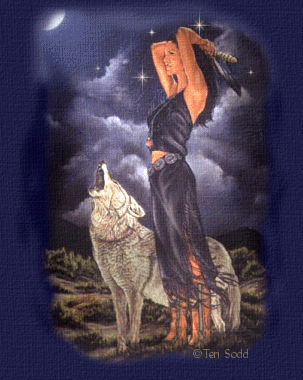
One of the most beautiful and haunting forms of communication found in our world is the howl of a wolf pack. Wolves use many
forms of vocalization to communicate; however, their howl is the most distinguishing. Wolves also growl, whimper, whine, bark,
and squeal, with each of these carrying different meanings. The whimpering or whining heard from wolves is often a display
of friendliness. Wolves use growls to threaten or inforce pack hierarchy, while barks are used to signal alarm.
The howl of a wolf provokes either pleasure or fear in humans. Howls are used by a pack to bring a pack together,
for celebration, or to protect their territory. The howl represents yet another sign of pack unity and the strength of that
unity. Listen to the audio clips below to hear the richness and beauty of howling wolves. The first clip shows how even pups
will join in a howl--listen carefully as they join in the end of the howl!
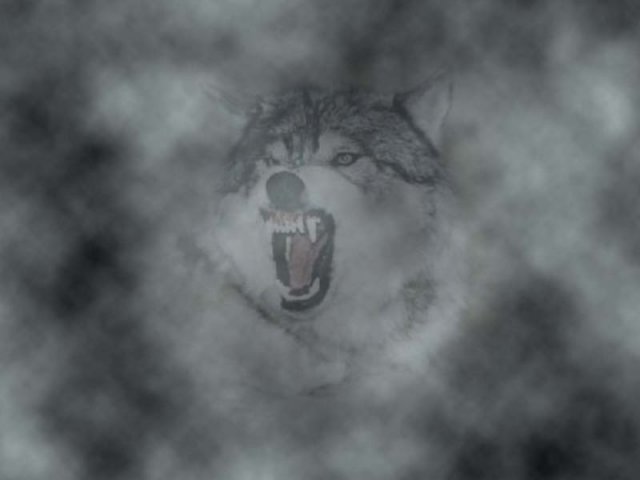
Wolves rely not only on howls to communicate, but their body language as well. Wolves use their entire body to communciate--their
stances, their facial expressions, their stares, and even their tails. Dominance can be shown by a wolf standing on its hind
legs, while submissive wolves may roll over on their back and expose their underside to a dominant male, as in the image to
the left.
One of the most telling forms of body languages that wolves utilize is the tail. The position of the tail
can indicate dominance, submission, aggression, fear, and other communications.
shows dominance, with the tail high
and curled. A high, wagging tail can mean that the wolf is in a playful mood.
Atucked tail. This is generally
how a wolf will display submissive behavior to a dominant wolf. Additionally, a tucked tail may also indicate fear.
A relaxed wolf will often just have it's tail hanging straight down, while a tense or aroused wolf will have a tail pointing
straight out, as in the image to the right. This can indicate that a wolf senses danger or is about to attack.
Wolves also use their eyes and their scent to communicate. The penetrating stare of a dominant wolf is yet another form
of communication used to maintain order within the pack. Scent markings are used to mark a pack's territory and this scent
communicates to other wolf packs that the territory is occupied.
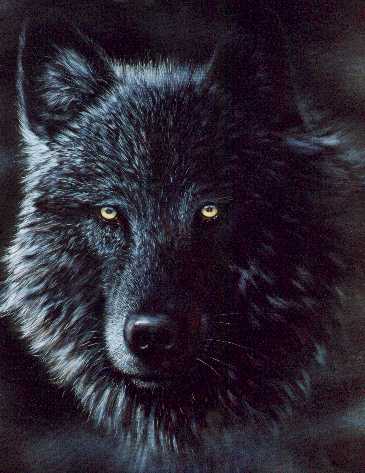
The wolf today is an endangered species. This creature, which once roamed freely over most of the North American continent
is now only found in isolated patches. The major reason for this endangerment is that wolves do not mix with humans. Like
many other forms of wildlife, the wolves habitat has dwindled because of human development. When wolves cannot find their
prey in the wild, they have been known to kill domesticated animals, from cattle to a family's pet. As a result, the wolf
has been one of the wild enemies of mankind, to be demonized in children's fairytales.
Public sentiment is now swaying
in favor of the wolves. Yet there are still many issues to consider about trying to build the wolf population back up and
off the endangered list. The same public who are now wolf advocates may feel differently when a wolf makes lunch out of a
treasured pet. Wolves need unsettled land to roam, breed, kill and survive. More and more humans want to live amongst the
wildlife. These well-intentioned people are also posing a threat to the wolves future. A balance must be achieved so wolves
can flourish with minimal harm, financial or otherwise, to the humans that share their habitat.
The key to human
understanding of wolves must come through education. This education must be unbiased, so that people know that although wolves
are intelligent and beautiful creatures, they are wild animals, not cute and cuddly like their domestic cousin, the dog. There
are several centers opening around the country that focus on the educational aspect, so as to increase public knowledge as
well as their sympathy. A few of these such centers are listed below:
The International Wolf Center in Ely, Minnesota.
The mission of this center is to educate about the wolf, the wolf's relationship with the environment and its relationship
with human beings.
Wolf Park in Battle Ground, Indiana is another such research and education center. This center is
important because it brings wolf education east of the Mississippi.
The Wolf Fund is an organization dedicated to the
reintroduction of wolves in Yellowstone National Park. This organization is driven more towards the reintroduction rather
than the education. However, even they realize the financial losses associated with wolves and ranches, so they also try to
find that crucial balance between humans and wolves.
Many of the perceptions of wolves stem from how the wolf is represented in stories--folklore, fiction, myths, and legends.
Many of the prevailing stories depict wolves in a negative way--such as in Aesop's Fables, Little Red Riding Hood and the
Three Little Pigs. Pictured here is Zeke, the big, bad wolf from the Three Little Pigs.
In fiction, the wolf is
sometimes represented as an evil, conniving carnivore which preys on small children and livestock. While wolves do sometimes
prey on livestock, they are responsible for a very small percentage of the livestock deaths in North America. Attacks by
healthy wild wolves on humans is almost unheard of, and there has never been a fatal attack on a human by a healthy wild wolf
in North America. Those attacks that do take place might involve an unhealthy wolf, or a human who is some how inticing the
wolf to action or impinging upon the wolf's territory.
Other cultures have better views of the wolf. In
Roman mythology, the god Mars considered the wolf a sacred animal, and the founders of Rome were raised by a wolf. Native
Americans also hold the wolf in high regard and believe that wolves carry characteristics that humans should also find important,
such as strong family structure and teaching the young. Eastern Europeans often viewed wolves as protectors of the harvest.
For many in North America, the negative perceptions of wolves will continue as is evidenced by some phrases
in our language: "cry wolf", "wolf at the door", "wolf in sheep's clothing", and "throw
it to the wolves". As time passes and education efforts continue, these perceptions seem to be changing to a more realistic
view of the wolf as a vital part of a balanced ecosystem.
There seems to be very little in the way of a 'middle
ground' about wolves. They will probably always be both revered and hated. However, perhaps humans will better understand
wolves by separating out the fact and the fiction.

|








